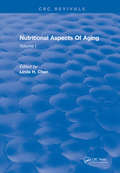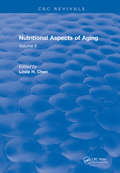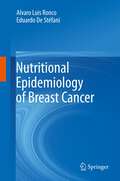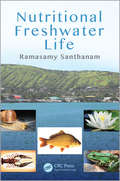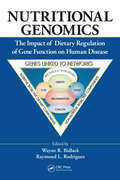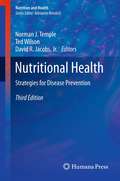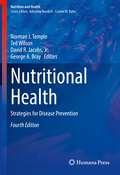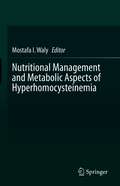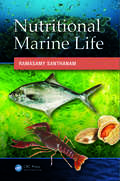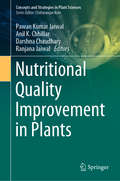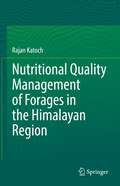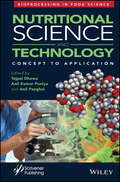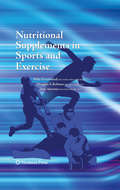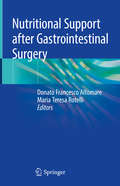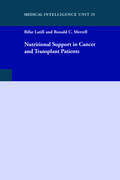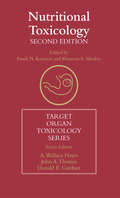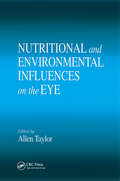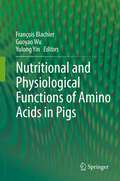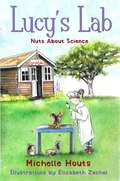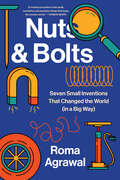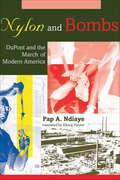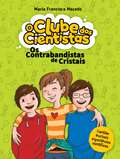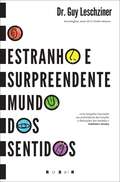- Table View
- List View
Nutritional Aspects Of Aging: Volume 1
by Linda H. ChenThe first section in Volume 1 describes the fundamentals of nutrition and aging which include research strategies for the study of nutrition and aging. The nutritional modulation of the aging process which has provided a major breakthrough in the field of nutrition and longevity is also discussed. These include biomedical influences, and social and psychological aspects. Section 3 includes dietary characteristics of the elderly population and methods for the assessment of nutritional status. The nutritional status of the elderly with respect to individual nutrients as determined by dietary survey and by biochemical methods is described in Section 4. Section 4 also includes discussion on nutrient metabolism, requirements, nutritional imbalances, and deficiencies of nutrients. Energy metabolism and obesity as a factor in pathogenesis of diseases are also discussed.
Nutritional Aspects Of Aging: Volume 2
by Linda H. ChenIn the first section of Volume 2, toxicological factors affecting nutritional status are discussed. Medications and alcohol may affect nutritional status. Section 2 provides a discussion of nutrition-related diseases which occur more frequently among the elderly. Cardiovascular diseases including coronary heart disease and cerebrovascular disease are the leading causes of death in the U.S. The relative importance of cardiovascular diseases, in terms of all deaths for the given age group, rises steadily with age. The death rate from these diseases is 28% for the middle age group (35 to 44) and is 69% for the old age group (age 75 and above. This reflects the continued progression of artherosclerosis with aging. Cancer is the second leading cause of death in the U.S. The death rate from cancer also rises steadily with age. The death rate from diabetes mellitus increases progressively with age and more rapidly after the age of 45. The incidence of diabetes mellitus is 0.23% under age 25 and 6.2% over 45.
Nutritional Epidemiology of Breast Cancer
by Alvaro Luis Ronco Eduardo De StéfaniThe book is the first one published exclusively on the field of nutritional epidemiology of breast cancer. It summarizes the currently existing knowledge, with an updated and comprehensive international bibliography (~ 1.000 references). The authors also performed a review on the epidemiological studies on nutrition and breast cancer carried out in Uruguay between 1994 and 2011, which allowed exploring and identifying the main risk and protective factors for the disease in this high-risk country. Epidemiologists, Nutritionists, Public Health managers and breast specialists -from the prevention to the treatment fields - will find in this book a unique source of technical information, which will contribute in expanding their knowledge and view of the disease.
Nutritional Freshwater Life
by Ramasamy SanthanamSupplying sustenance for millions of the poorest people in the world, freshwater flora and fauna also contribute to overall economic well-being by means of export commodity trade, tourism, and recreation. As sources of high-quality nutrients, freshwater flora and fauna of edible value represent a viable option for alleviating the problems related t
Nutritional Genomics: The Impact of Dietary Regulation of Gene Function on Human Disease
by Raymond L. Rodriguez Wayne R. BidlackThe notion of matching diet with an individual's genetic makeup is transforming the way the public views nutrition as a means of managing health and preventing disease. To fulfill the promise of nutritional genomics, researchers are beginning to reconcile the diverse properties of dietary factors with our current knowledge of genome structure and g
Nutritional Health
by Norman J. Temple Ted Wilson David R. Jacobs Jr.Now going into its third much-expanded edition, the highly praised Nutritional Health: Strategies for Disease Prevention has been brought fully up to date to include all the new thinking and discoveries that have the greatest capacity to improve human health and nutritional advancement. About half the new edition will be revised and updated from the second edition while the other half will consist of major revisions of previous chapters or new subjects. Like the two previous editions the book will consist of general reviews on various topics in nutrition, especially those of much current interest. The authors provide extensive, in-depth chapters covering the most important aspects of the complex interactions between diet, its nutrient components, and their impacts on disease states, and on those health conditions that increase the risk of chronic dieases. Up to date and comprehensive, Nutritional Health: Strategies for Disease Prevention, Third Edition offers physicians, dietitians, and nutritionists a practical, data-driven, integrated resource to help evaluate the critical role of nutrition.
Nutritional Health: Strategies for Disease Prevention (Nutrition and Health)
by Norman J. Temple George A. Bray Ted Wilson David R. Jacobs Jr.This fourth edition brings together a diverse range of experts in nutrition-related areas to discuss recent thinking and discoveries in nutrition, especially in relation to topics that have the greatest capacity to improve human health and nutritional implementation. An overview of nutrition science in the third decade of the twenty-first century reveals that much water has flown under the bridge of the advancing river that is nutrition research and practice. With these large accumulations of developments in the field of nutrition, the need for a new edition of this book is obvious. Our vastly improved nutrition knowledge gives us the capability of preventing a sizable fraction of the chronic diseases that afflict the people of our world, but only if these discoveries can be translated into effective action at the population level. Nutritional Health endeavours to address the needs of those who would most benefit from up-to-date information on key areas in the field of nutrition.The book starts with a discussion of the nature of nutritional research then moves into an overview of the most important aspects of the complex interactions between diet, its nutrient components, and their impacts on disease states, and on those health conditions that increase the risk of chronic diseases. Parts three and four discuss diet and include new chapters on the Mediterranean diet, the DASH diet, the flexitarian diet, and the low-carbohydrate diet. The final two parts of the book discuss emerging trends in nutrition science, such as gut microbiome and sustainable diet, and areas of controversy in nutrition, such as the influence of the food industry and dietary supplements. Up to date and comprehensive, Nutritional Health: Strategies for Disease Prevention, Fourth Edition offers physicians, dietitians, and nutritionists a practical, data-driven, integrated resource to help evaluate the critical role of nutrition.
Nutritional Management and Metabolic Aspects of Hyperhomocysteinemia
by Mostafa I. WalyElevated blood concentrations of homocysteine, B vitamins deficiencies and oxidative stress are etiological factors for many human chronic diseases, yet the etiologic relationship of hyperhomocysteinemia to these disorders remains poorly understood. Clinical trials continue to support the notion that hyperhomocysteinemia is involved in the pathogenesis of oxidative stress and its associated impairment of cellular redox status. Antioxidants, phytochemicals, and bioactive agents are thought to be associated with the reduction of oxidative stress and reducing risk of chronic diseases, yet their role in preventing hyperhomocysteinemia-mediated oxidative stress has not been well covered in the literature. Nutritional Management and Metabolic Aspects and of Hyperhomocysteinemia comprehensively covers the nutritional-based intervention for combating hyperhomocysteinemia-mediated oxidative stress, metabolic regulation of homocysteine-dependent transulfuration and transmethylation pathways, and the identification of novel biomarkers for early diagnosis of hyperhomocysteinemia. The main goal of this text is to address the biochemical and nutritional aspects of hyperhomocysteinemia in relation to increasing risk of chronic diseases, providing insight into the etiology of hyperhomocysteinemia and covering new research on the effective reduction and management of hyperhomocysteinemia-associated chronic diseases. For researchers seeking a singular source for the understanding of the biochemical aspects and nutrition-based combat of hyperhomocysteinemia, its risk factors, preventive measures, and possible treatments currently available, this text provides all of the important needed information in up-to-date and comprehensive form.
Nutritional Marine Life
by Ramasamy SanthanamThe nutritional benefits of marine flora and fauna are well known. Fish and crustaceans provide high-quality sources of amino acids-nutritionallyimportant proteins found in only small amounts in cereals and grains. Nutrients and minerals in seafood can improve brain development and reproduction and there are strong links between fish and heart heal
Nutritional Quality Improvement in Plants (Concepts and Strategies in Plant Sciences)
by Pawan Kumar Jaiwal Anil K. Chhillar Darshna Chaudhary Ranjana JaiwalThis book presents a detailed overview and critical evaluation of recent advances and remaining challenges in improving nutritional quality and/or avoiding the accumulation of undesirable substances in plants using a variety of strategies based on modern biological tools and techniques. Each review chapter provides an authoritative and insightful account of the various aspects of nutritional enhancement of plants. In the course of the last two decades, several food crops rich in macro- and micronutrients have been developed to improve health and protect a large section of the populace in developing countries from chronic diseases. Providing extensive information on these developments, this book offers a valuable resource for all researchers, students and industrialists working in agriculture, the plant sciences, agronomy, horticulture, biotechnology, food and nutrition, and the soil and environmental sciences.
Nutritional Quality Management of Forages in the Himalayan Region
by Rajan KatochThe book discusses up-to-date and detailed information about the nutritional quality of forage in the biodiversity-rich Himalayan region and their potential in livestock feeding.• Provides a comprehensive discussion on the prospects of Himalayan forages.• Collates findings and data based on more than two decades of research on nutritional quality of different temperate grasses, fodder trees, legumes and non-conventional forage resources.• Includes information on different forage resources, nutritional quality of forages, niche based nutritive forage species, varietal improvement of different species for nutritionally rich forages, non-conventional forages and modern biotechnological intervention for quality improvement of forages.• Offers a valuable resource of information on forages for researchers and policymakers• Include information oriented toward livestock feeding, influencing their health, production and productivity affecting economic status of farmers.• Presents exhaustive information on forage species along with pictorial presentations. The target audience will be researchers and scientists in public and private institutions (e.g. government, academia, dairy industry), policy planners, animal nutritionists and students. The monograph is relevant for the readers interested in understanding forage quality for livestock feeding and suggest models for quality improvement of forages worldwide, in similar topographies. It is also relevant to the researchers studying forage improvement and biofortification for nutritional enhancement for improving livestock health and productivity
Nutritional Science and Technology: Concept to Application (Bioprocessing in Food Science)
by Anil Kumar Puniya Tejpal Dhewa Anil PanghalNUTRITIONAL SCIENCE AND TECHNOLOGY Food science is a rapidly changing and complicated subject. This new series addresses the current state-of-the-art concepts and technologies associated with the industry and will cover new ideas and emerging novel technologies and processes. The book Nutritional Science and Technology: Concept to Application in the series, “Bioprocessing in Food Science,” is an excellent resource for any scientist, engineer, student, or other industry professional interested in this topic. It covers a wide range of topics, including human nutrition, technological processes, the health benefits of fermented foods, and food safety concerns. The content contributors and editors are experts in the field, and their primary goal is to provide extensive knowledge about recent technologies in nutritional science and technology to students, researchers, and industry professionals. Manufacturers are looking for new possibilities to occupy a growing share of the rapidly changing food market, and this book will enable them to make informed decisions about adopting appropriate processing technology, implementation, economics, and constraints of different technologies. The book also provides insights on advances in nutritional science and technology for healthy and safe nutrition, with maximum illustrations of how to ensure public health safety and adequate nutrition. Overall, this book is a comprehensive overview of this study area and a valuable resource for anyone interested in this field.
Nutritional Supplements in Sports and Exercise
by Mike Greenwood Jose Antonio Douglas KalmanIn the ever-growing field of sports nutrition and nutritional supplementation, it is imperative to have a comprehensive and extensive guide, which is exactly what Nutritional Supplements in Sports and Exercise provides. The editors and authors have skillfully structured their research and findings as they deliver an accessible wealth of knowledge to the general population, while also maintaining academic and professional integrity through quality based and advanced scientific research, which renders it useful in the professional environment by sports nutritionists, exercise physiologists, strength and conditioning/personal trainers, athletic trainers, registered dietitians, college/ professional sports affiliates, and academic programs. Not only does Nutritional Supplements in Sports and Exercise significantly cover the physical aspects of supplement usage, but it also expands its breadth as it notes the psychological effects upon users and discusses its various governmental regulations, and attempts to understand the future of nutritional supplements as the industry continues its likely growth. Nutritional Supplements in Sports and Exercise covers a timely subject, and offers interested readers knowledgeable insight into a rising industry plagued by concerns and question.
Nutritional Support after Gastrointestinal Surgery
by Donato Francesco Altomare Maria Teresa RotelliThis volume provides readers with the necessary information to select the most appropriate nutritional support following gastrointestinal tract surgery.Most patients are worried about resuming oral intake, particularly when the surgery has altered the GI tract normal physiology removing organs (e.g. total colectomy) or part of them, or modifying the natural sequence of the different GI tract parts (e.g. after esophagectomy or pancreatectomy). Patients may also worry about the possible complications of an inappropriate alimentation. As a matter of fact, several metabolic processes can be modified by GI tract surgery (e.g. major liver resection or pancreatectomy), thus making the nutritional support essential: and the same support is fundamental in bariatric surgery, nowadays widely used for super-obese patients. There is therefore a need for a nutritional guide in surgery and in troubleshooting postoperative cases where nutrition is a major issue This book offers nutritionists insights into the possible alterations of GI tract physiology occurring after surgery, and will be a valuable resource for surgeons, gastroenterologists, coloproctologists, nutritionists and clinical specialist nurses, seeking guidance on postoperative nutrition.
Nutritional Support in Cancer and Transplant Patients
by Rifat Latifi Ronald C. MerrellMuch has been learned, great developments have occurred, and so much has been written about cancer and transplantation in the last 2-3 decades. Yet, to the author's knowledge, no monograph or book has addressed nutrition support of cancer and transplant patients together. Experts from the around the world have addressed the nutrition support in cancer and transplant patients in this unique monograph. The book is divided in two parts: Part I deals with nutrition support in cancer patients, including the specific role of nutrition on immunity, cancer cachexia, and the role of different substrates. Part II addresses nutrition in transplant patients. The first two chapters deal with the immunologic role of nutrition and cancer cachexia. Chapter 3 elegantly and extensively reviews the nutritional implications; its biochemistry and the role of one of the most studied amino acids in clinical practiceNglutamine. This is followed by two chapters of nutrition support of patients with head and neck cancer and nutrition support of patients with gastrointestinal cancer. Chapters 6 and 7 review the role of total parenteral nutrition on perioperative nutritional support and cell cycle kinetics. While the plasma amino acids profile in cancer patients and the role of L-methionine is addressed in great details in Chapters 8 and 9, the role of ornithine alpha-ketoglutarate administration on surgical, trauma and cancer-bearing patients is reviewed on Chapter 10. Part Two of this book starts with the review of nutritional support in small bowel transplantation. This Section elegantly describes the process of recovery of small bowel from the ischemia and preservation, weaning from parenteral nutrition support and establishment of normal diets. In addition monitoring techniques and the nutritional complications of surgical intervention is described. Chapter 12 on liver failure and liver transplant patients addresses hepatic encephalopathy and the role of certain amino acids, nutrition assessment techniques and metabolic changes following liver transplantation. Furthermore, it offers some practical advice on how to establish nutrition support routes in these very ill patients. Nutrition support in renal transplantation, including metabolic abnormalities in renal failure, are described on Chapter 13. This monograph ends with a Chapter on total parenteral nutrition in bone marrow transplant patients.
Nutritional Toxicology
by Frank N. Kotsonis Maureen A. MackeyNutrients are gaining recognition for their role in protecting against the toxic effects of free radicals, alcohol and other substances. At the same time, advances in food technology, the appearance of novel foods and new ingredients have generated new toxicological issues and forced health and safety professionals to develop new and more reliable
Nutritional Toxicology
by Lishi ZhangThis book provides a broad overview of the chemicals in food that have the potential to induce adverse health effects. Nutritional Toxicology is an interaction of nutrition, toxicology, biochemistry and food science, etc. Its main research scope involves the effects of nutrients on metabolisms of toxicants and their mechanisms, the interaction of the toxicants and contaminants originated from diet with nutrients and nutrition process, the adverse health outcome of nutrients excess, as well as methodology of research and related food and nutrition regulation process. Also the risk assessment of toxicants and contaminants in foods, and risk benefit assessment of nutrients (dietary supplementation) has become an emerging topic. This book provides novel and provocative insights into the fields of nutrition, food science and toxicology. It also offers a state-of-the-art report on recent discoveries concerning nutritional toxicology and where the field is going. It mainly focuses on advances made over the past 20 years. It will benefit graduate students, researchers and food and nutrition related regulation parties.
Nutritional and Environmental Influences on the Eye (Modern Nutrition Ser.)
by Allen TaylorSignificant advancements in nutrition's impact on the eye have occurred faster than any volume can document... until now. This book gives the background and rationale regarding the physiological damage caused by biological oxidants as well as the rationale for the protective roles for nutrient-antioxidants and how they affect the risk for cataracts. This volume also contains information on how to quantitatively assess age-related diseases of the eye including cataracts and age-related maculopathy. Smoking and light exposure as factors for age-related eye diseases as well as the utility of potential anticataract pharmaceuticals is discussed.
Nutritional and Physiological Functions of Amino Acids in Pigs
by Francois Blachier Guoyao Wu Yulong YinThis book provides developmental data regarding piglets (with a focus on the gastrointestinal tract), data related to amino acid metabolism in pigs, data related to nutritional and physiological functions of amino acids in pigs, nutritional requirements for amino acids in pigs, signaling roles of amino acids, methodological aspects in amino acid research and the pig model for studying amino acid-related human diseases.
Nuts About Science: Lucy's Lab #1 (Lucy?s Lab)
by Michelle Houts Elizabeth ZechelOn Lucy’s first day of second grade, she’s excited to meet her new teacher, Miss Flippo, and find out everything’s she’s going to learn about this year in school. And when Miss Flippo tells the class that they’re going to have their very own science lab, complete with lab coats and goggles, Lucy can’t wait to start exploring.But one thing is troubling her. The tree that sat outside her first grade classroom all year is gone. Where are the squirrels going to live? Inspired by her classroom lab, Lucy starts her own research mission to find out what happened to the tree, and then to lobby for the school to plant a new one. With the help of her cousin, Cora, and their new classmates, Lucy discovers that science is everywhere you look, and a lab can be anywhere you look.Launching a new chapter book series from IRA Children’s Book Award-winner, Michelle Houts, Lucy Saves Some Squirrels draws on STEM themes and is aligned with curriculum guidelines to bring a love of science to young readers, inspiring them to start their own labs and explore their world.
Nuts and Bolts: Seven Small Inventions That Changed The World In A Big Way
by Roma AgrawalShortlisted for the 2023 Royal Society Science Book Prize “A riveting love letter to the small, wonderful, and mundane things that make the modern world.”—Roman Mars A structural engineer examines the seven most basic building blocks of engineering that have shaped the modern world. Some of humanity’s mightiest engineering achievements are small in scale—and, without them, the complex machinery on which our modern world runs would not exist. In Nuts and Bolts, structural engineer Roma Agrawal examines seven of these extraordinary elements: the nail, the wheel, the spring, the magnet, the lens, the string, and the pump. Tracing the evolution from Egyptian nails to modern skyscrapers, and Neanderthal string to musical instruments, Agrawal shows us how even our most sophisticated items are built on the foundations of these ancient and fundamental breakthroughs. She explores an array of intricate technologies—dishwashers, spacesuits, microscopes, suspension bridges, breast pumps—making surprising connections, explaining how they work, and using her own hand-drawn illustrations to bring complex principles to life. Alongside deeply personal experiences, she recounts the stories of remarkable—and often uncredited—scientists, engineers, and innovators from all over the world, and explores the indelible impact these creators and their creations had on society. In preindustrial Britain, nails were so precious that their export to the colonies was banned—and women were among the most industrious nail makers. The washing machine displayed at an industrial fair in Chicago in 1898 was the only machine featured that was designed by a woman. The history of the wheel, meanwhile, starts with pottery, and takes us to India’s independence movement, where making clothes using a spinning wheel was an act of civil disobedience. Eye-opening and engaging, Nuts and Bolts reveals the hidden building blocks of our modern world, and shows how engineering has fundamentally changed the way we live.
Nylon and Bombs: DuPont and the March of Modern America (Studies in Industry and Society)
by Pap A. NdiayeWhat do nylon stockings and atomic bombs have in common? DuPont. The chemical firm of DuPont de Nemours pioneered the development of both nylon and plutonium, playing an important role in the rise of mass consumption and the emergence of the notorious "military-industrial complex." In this fascinating account of the lives and careers of Du Pont’s chemical engineers, Pap A. Ndiaye deftly illustrates the contribution of industry to the genesis of a dominant post–World War II "American model" connecting prosperity with security.The consumer and military dimensions of twentieth-century American history are often studied separately. Ndiaye reunites them by examining Du Pont's development of nylon, which symbolized a new way of life, and plutonium, which was synonymous with annihilation. Reflecting on the experiences and contributions of the company's engineers and physicists, Ndiaye traces Du Pont's transformation into one of the corporate models of American success.
Nylon and Bombs: DuPont and the March of Modern America (Studies in Industry and Society)
by Pap A. NdiayeHow the chemical engineering behemoth that brought us Teflon, Kevlar, Lycra, Freon, and more shaped the culture of postwar America. What do nylon stockings and atomic bombs have in common? DuPont. The chemical firm of DuPont de Nemours pioneered the development of both nylon and plutonium, among countless other innovations, playing an important role in the rise of mass consumption and the emergence of the notorious &“military-industrial complex.&” In this fascinating account of the lives and careers of Du Pont&’s chemical engineers, Pap A. Ndiaye deftly illustrates the contribution of industry to the genesis of a dominant post–World War II &“American model&” connecting prosperity with security. The consumer and military dimensions of twentieth-century American history are often studied separately. Ndiaye reunites them by examining Du Pont&’s development of nylon, which symbolized a new way of life, and plutonium, which was synonymous with annihilation. Reflecting on the experiences and contributions of the company&’s engineers and physicists, Ndiaye traces Du Pont&’s transformation into one of the corporate models of American success.</
O Clube dos Cientistas 1: Os Contrabandistas de Cristais
by Maria Francisca MacedoÉs curioso e fascinado por ciência? Então vem conhecer O Clube dos Cientistas! A Catarina, o Chico e o Carlos são três irmãos curiosos, fascinados pela ciência e sempre em busca de mistérios. Vais divertir-te a ler as suas histórias empolgantes e cheias de ação! Se fores como eles, não vais resistir a ler o Caderno de Experiências até ao fim e pôr mãos à obra. O fumo numa cabana abandonada despertou a curiosidade dos três irmãos. O que começou por ser apenas uma brincadeira, transformou-se numa grande aventura! Conseguirão eles resolver o mistério que têm em mãos? Junta-te ao Clube dos Cientistas e vem descobrir Os Contrabandistas de Cristais! Autora distinguida pelo GLOBAL TEACHER PRIZE 2018 (Prémio para o Melhor Professor de Portugal), com uma Menção Honrosa pelo elevado contributo para a Educação e Sustentabilidade Social.
O Estranho e Surpreendente Mundo dos Sentidos
by Guy LeschzinerCOMO OS SENTIDOS MOLDAM A NOSSA PERCEÇÃO DO MUNDO Os nossos sentidos são vitais para a compreensão de tudo o que nos rodeia. Eles enriquecem as nossas experiências de vida e são parte integrante das nossas memórias. No entanto, são falíveis e inconsistentes, vulneráveis a diferenças entre indivíduos e a doenças, pelo que aquilo que consideramos ser real não é mais do que uma reconstrução complexa, uma realidade virtual criada pelo nosso cérebro. A verdade é que os nossos sentidos podem trair-nos, oferecendo-nos a sua própria interpretação do que podemos ver, ouvir, cheirar, tocar ou sentir. Neste livro, o Dr. Guy Leschziner, um conceituado neurologista, apresenta-nos histórias reais e extraordinárias de pessoas cujos sentidos foram alterados de alguma forma, com consequências inesperadas e por vezes devastadoras: pessoas a quem as palavras ativam as papilas gustativas, produzindo um verdadeiro sabor; pessoas cegas que têm uma visão pormenorizada e vívida; pessoas para quem as sensações de quente e frio se invertem. Estes relatos surpreendentes demonstram as limitações dos sentidos, a sua dependência do bom funcionamento do nosso sistema nervoso e, mais importante, o modo como a perceção do mundo pode ser bastante diferente da realidade para cada um de nós. «Um mergulho fascinante nas profundezas das funções e disfunções dos sentidos.» Publishers Weekly «Um livro profundamente comovente e poderoso, repleto de ideias provocadoras sobre a perceção humana e a forma como construímos a realidade.» DANIEL M. DAVIS, autor de O Incrível Sistema Imunitário «Um livro intenso, divertido e excecional. O professor Leschziner conduz-nos numa viagem de exploração dos nossos sentidos, fazendo-nos questionar a natureza da nossa realidade e a forma como interpretamos o mundo que nos rodeia.» Dr. Alistair Stanhouse, psiquiatra e autor de Head First «Através de histórias vívidas de doenças que afetam os nossos sentidos, o professor Leschziner faz uma análise profunda da imensidão de experiências sensoriais presentes em todos os momentos das nossas vidas, mas de que quase não estamos conscientes. Uma fantástica abordagem da neurociência à compreensão dos sentidos.» Allan Ropper, autor bestseller internacional «Fiquei encantada desde o primeiro parágrafo. Através de histórias reais sobre o que acontece quando a nossa frágil perceção do mundo que nos rodeia é afetada, o Dr. Guy Leschziner liga-nos de novo aos nossos sentidos.» Professora Alice Roberts, autora, anatomista e antropóloga
